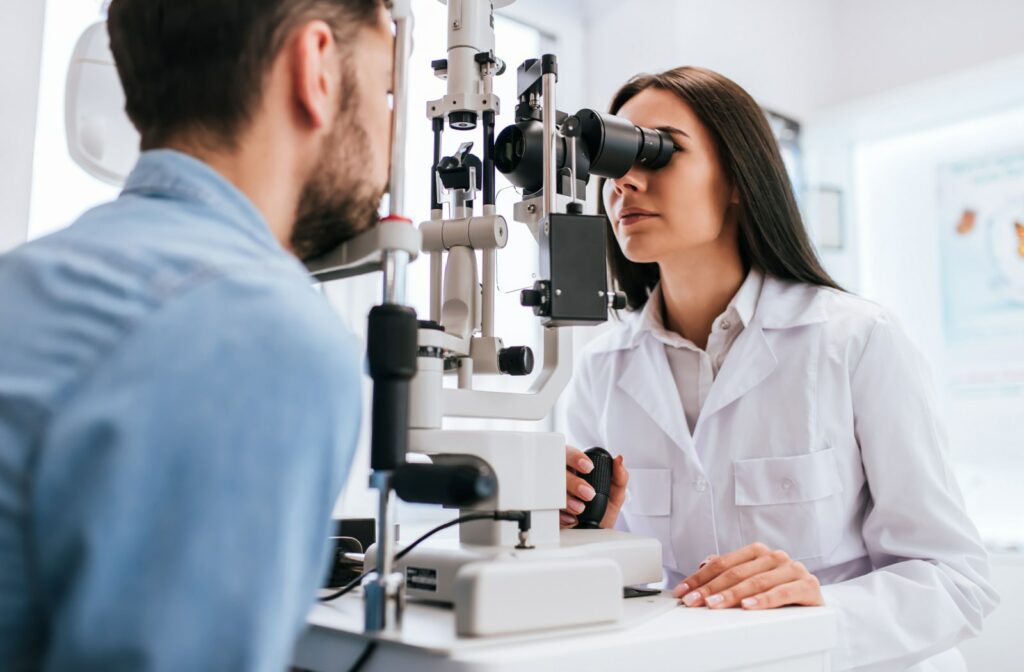Regular eye exams help to preserve your vision and overall health. How often you have an eye exam isn’t about personal preference but rather a preventative and proactive approach to eye care.
The frequency of eye exams for children, adults, and seniors usually depends on age, underlying health factors, and your risk for eye diseases.
With yearly eye exams, your eye doctor can monitor your eye health and recommend treatment if necessary. At-risk or patients with pre-existing conditions may require more frequent eye exams.
The Importance of Eye Exams
An eye exam is a comprehensive evaluation of the health and function of your eyes conducted by an optometrist or ophthalmologist. It involves various tests and procedures to assess your vision, eye movements, coordination, and overall ocular health.
Regular eye exams are important because they help detect potential problems with your vision or otherwise asymptomatic eye conditions and diseases early on. By catching any issues in their early stages, your eye doctor can treat and manage them effectively, reducing the risk of permanent vision loss or other complications.
Moreover, an eye exam is not just about correcting any visual impairments; it can also reveal underlying health conditions that may otherwise go undetected. For example, eye exams also play a crucial role in monitoring and managing chronic health conditions such as diabetes, high blood pressure, and autoimmune diseases that can impact eye health.
In addition to maintaining good eye health, regular exams allow for more precise and personalized vision correction through updated prescriptions or adjustments to visual aids like glasses or contact lenses. They also allow you to discuss any concerns or changes in your vision with a trained eye care professional.
What Happens During an Eye Exam?
An eye exam can take anywhere from 30 to 60 minutes. During this time, your eye doctor will first discuss your eye and medical history, current eye health, medications you take, and prescriptions.
Next, they may conduct the following tests:
- Visual acuity to determine how well you see
- Prescription for corrective lenses
- Pupillary response
- Peripheral or side vision
- Eye movement to assess how well your eyes work together
- Check the eyelids, cornea, iris, and lens
- Check the retina and optic nerve at the back of the eye
- Tonometry test to check the eye pressure for glaucoma
Once the testing is complete, your eye doctor will discuss the findings and may recommend further testing if needed or provide treatment to prevent the worsening of a condition and preserve vision.
How Often Should You Have an Eye Exam?
Depending on your individual eye care needs, your eye doctor will determine how often you should have an eye exam, together with the recommendation by the Alberta Association of Optometrists.
Infants & Toddlers
Children can develop vision problems at birth. For this reason, infants and toddlers from birth to 24 months should have their first comprehensive eye exam between 6 and 9 months.
Preschool Children
The majority of learning in early childhood is through visual means. For this reason, preschool children aged 2 to 5 years should have at least one comprehensive eye exam to help detect and correct vision problems before they progress or affect school performance.
School-Aged Children
School-aged children between 6 and 19 should have yearly comprehensive eye exams to maintain good vision and eye health. It’s important to note that sight tests or school vision screenings are not comprehensive eye exams and usually only determine the lens power, and comprehensive eye exams can help diagnose, manage, treat, and prevent eye diseases, conditions, and disorders.
Adults
Adults aged 20 to 64 should have a comprehensive eye exam every 1 to 2 years. These exams are not just for adjusting refractive errors but also provide preventative measures against conditions like cataracts and glaucoma, which can develop with age and without noticeable symptoms in the early stages.
Seniors
Seniors aged 65 and older should have a comprehensive eye exam annually. The frequency for high-risk patients or patients with pre-existing conditions is determined based on the findings from your eye doctor during your initial examination.
What Is High Risk?
The following factors can indicate if you’re at a higher risk for developing eye problems:
- Premature birth or low birth weight
- Family medical history
- Strabismus or congenital eye disorders
- Children experiencing difficulty at school
- Reading or learning disabilities
- Diabetes, high blood pressure
- Family history of glaucoma
- Those with visually demanding work or who face eye hazards
- Those taking systemic medication with ocular side effects
Proactive & Preventative Approach
An eye exam is essential for preserving your vision and promoting eye and overall health. Book an appointment with Eye Effects based on the age-specific guidelines, risks, and underlying health conditions outlined above.
If you have any questions about eye exams and the process or have concerns about vision changes, take a proactive and preventative approach and contact us.


